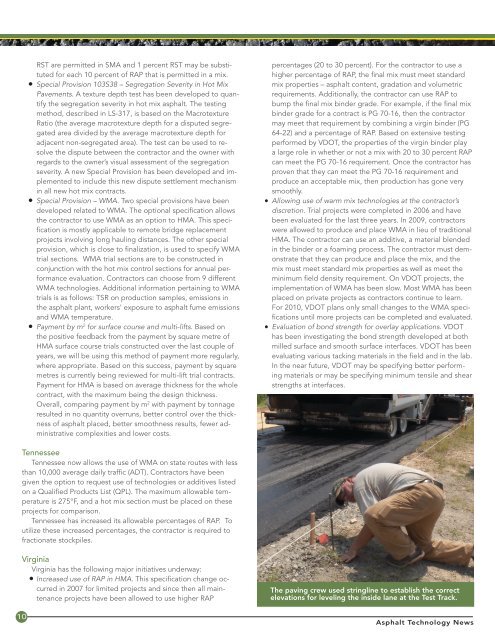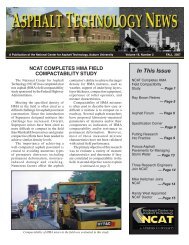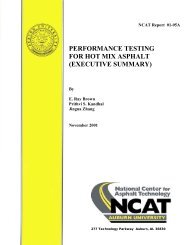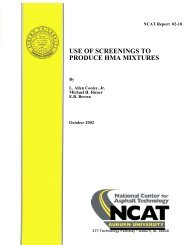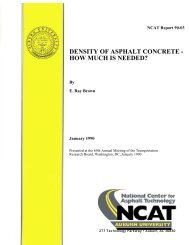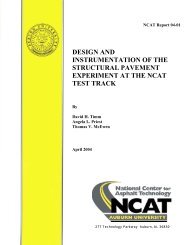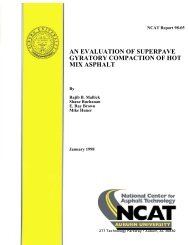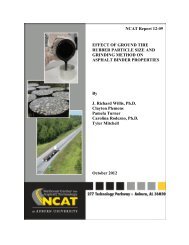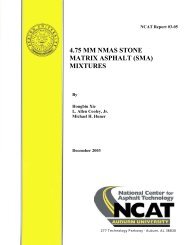RST are permitted in SMA and 1 percent RST may be substitutedfor each 10 percent of RAP that is permitted in a mix.• Special Provision 103S38 – Segregation Severity in Hot MixPavements. A texture depth test has been developed to quantifythe segregation severity in hot mix asphalt. The testingmethod, described in LS-317, is based on the MacrotextureRatio (the average macrotexture depth for a disputed segregatedarea divided by the average macrotexture depth foradjacent non-segregated area). The test can be used to resolvethe dispute between the contractor and the owner withregards to the owner’s visual assessment of the segregationseverity. A new Special Provision has been developed and implementedto include this new dispute settlement mechanismin all new hot mix contracts.• Special Provision – WMA. Two special provisions have beendeveloped related to WMA. The optional specification allowsthe contractor to use WMA as an option to HMA. This specificationis mostly applicable to remote bridge replacementprojects involving long hauling distances. The other specialprovision, which is close to finalization, is used to specify WMAtrial sections. WMA trial sections are to be constructed inconjunction with the hot mix control sections for annual performanceevaluation. Contractors can choose from 9 differentWMA technologies. Additional information pertaining to WMAtrials is as follows: TSR on production samples, emissions inthe asphalt plant, workers’ exposure to asphalt fume emissionsand WMA temperature.2• Payment by m for surface course and multi-lifts. Based onthe positive feedback from the payment by square metre ofHMA surface course trials constructed over the last couple ofyears, we will be using this method of payment more regularly,where appropriate. Based on this success, payment by squaremetres is currently being reviewed for multi-lift trial contracts.Payment for HMA is based on average thickness for the wholecontract, with the maximum being the design thickness.Overall, comparing payment by m 2 with payment by tonnageresulted in no quantity overruns, better control over the thicknessof asphalt placed, better smoothness results, fewer administrativecomplexities and lower costs.percentages (20 to 30 percent). For the contractor to use ahigher percentage of RAP, the final mix must meet standardmix properties – asphalt content, gradation and volumetricrequirements. Additionally, the contractor can use RAP tobump the final mix binder grade. For example, if the final mixbinder grade for a contract is PG 70-16, then the contractormay meet that requirement by combining a virgin binder (PG64-22) and a percentage of RAP. Based on extensive testingperformed by VDOT, the properties of the virgin binder playa large role in whether or not a mix with 20 to 30 percent RAPcan meet the PG 70-16 requirement. Once the contractor hasproven that they can meet the PG 70-16 requirement andproduce an acceptable mix, then production has gone verysmoothly.• Allowing use of warm mix technologies at the contractor’sdiscretion. Trial projects were completed in 2006 and havebeen evaluated for the last three years. In 2009, contractorswere allowed to produce and place WMA in lieu of traditionalHMA. The contractor can use an additive, a material blendedin the binder or a foaming process. The contractor must demonstratethat they can produce and place the mix, and themix must meet standard mix properties as well as meet theminimum field density requirement. On VDOT projects, theimplementation of WMA has been slow. Most WMA has beenplaced on private projects as contractors continue to learn.For 2010, VDOT plans only small changes to the WMA specificationsuntil more projects can be completed and evaluated.• Evaluation of bond strength for overlay applications. VDOThas been investigating the bond strength developed at bothmilled surface and smooth surface interfaces. VDOT has beenevaluating various tacking materials in the field and in the lab.In the near future, VDOT may be specifying better performingmaterials or may be specifying minimum tensile and shearstrengths at interfaces.TennesseeTennessee now allows the use of WMA on state routes with lessthan 10,000 average daily traffic (ADT). Contractors have beengiven the option to request use of technologies or additives listedon a Qualified Products List (QPL). The maximum allowable temperatureis 275°F, and a hot mix section must be placed on theseprojects for comparison.Tennessee has increased its allowable percentages of RAP. Toutilize these increased percentages, the contractor is required tofractionate stockpiles.VirginiaVirginia has the following major initiatives underway:• Increased use of RAP in HMA. This specification change occurredin 2007 for limited projects and since then all maintenanceprojects have been allowed to use higher RAP10The paving crew used stringline to establish the correctelevations for leveling the inside lane at the Test Track.<strong>Asphalt</strong> <strong>Technology</strong> <strong>News</strong>
Research Round-UpLaboratory Refinement andField Validation of 4.75 mmSuperpave Designed<strong>Asphalt</strong> Mixtures(West, Heitzman, Rausch and Julian)As state and local transportation departments search for waysto maintain their roads with smaller budgets, one of the best investmentscan be thin overlays. Many agencies have found that4.75 mm nominal maximum aggregate size (NMAS) mixtures area perfect niche type for overlays as thin as 3/4 inch. These mixturesare also ideal for leveling courses, rich bottom mixes, andbicycle and pedestrian trails. They are typically composed almostentirely of fine aggregate and are very fine-graded, which makesthem easy to place and work by hand for good joints and featheringcapability. The down side of the fine gradations is that 4.75mm mixtures often have high asphalt contents, can be tender andsusceptible to scuffing and permanent deformation, and they lackmacro-texture, which is important to skid resistance in wet weather.NCAT began work on a pooled fund study in 2005 to refine thecurrent AASHTO mix design criteria for 4.75 mm NMAS Superpave-designedmixes. Nine states (Alabama, Connecticut, Florida,Minnesota, Missouri, New Hampshire, Tennessee, Virginia, andWisconsin) sponsored the pooled fund project. The objective ofthe study was to make recommendations on how to adjust criteriafor 4.75 mm mixes that will improve their permanent deformationresistance without sacrificing durability.Lab PhaseThe laboratory phase incorporated a total of 29 mix designs usingaggregate from each participating state. For each state, a 4.75mm mix was designed using 50 gyrations and a design air voidcontent of 4.0 percent. Additional mixes were also designed withvarying combinations of compaction effort (50 and 75 gyrations)and design air void contents (4 and 6 percent). Other mixes weredesigned to evaluate changes in other mix parameters, includingdust content and binder grade. Also included in the study werefour plant-produced baseline 4.75 mm mixes that have been usedsuccessfully in Georgia, Maryland, Michigan, and Mississippi.The compaction levels (50 and 75 gyrations) were selectedbecause 4.75 mm mixes are likely to be used for low traffic volumeapplications of less than 3 million equivalent single axle loads(ESALs). The design air void contents (4.0 and 6.0 percent) were selectedto investigate the concern that these mixes tend to be overasphalteddue to high values for voids in mineral aggregate (VMA).For each mix design and baseline mix, four performance testswere conducted. The mixes were tested for susceptibility to moisturedamage by determining the tensile strength ratio (TSR) accordingto AASHTO T 283. Permeability was determined using theformer ASTM provisional standard 129. Samples for moisture sensitivityand permeability were prepared at 9 ± 0.5 percent air voidsbecause these mixes are likely to have in-place voids between 8and 10 percent. Permanent deformation was evaluated accordingFall 2009 • Vol. 21 • No. 2to AASHTO TP 63-03 using the Material Verification Tester (MVT),which is a compact version of the <strong>Asphalt</strong> Pavement Analyzer(APA). To evaluate durability, samples were tested using an indirecttension test, and fracture energy density, defined as the area underthe stress-strain curve to the point of fracture, was calculated.A fracture energy ratio was determined by dividing fracture energydensity for long-term aged samples by the fracture energy densityof unaged samples.Findings from the laboratory research were:• Aggregate characteristics and blend gradations largely controloptimum asphalt contents. The average optimum asphalt contentfor the 29 mixes was 8.4 percent, which is relatively highfor Superpave-designed mixes. The average effective asphaltcontent was 6.8 percent.• As all of the aggregate blends in this study were consideredfine-graded, those that were slightly coarser (closer to themaximum density line) had lower VMA.• VMA was not affected by changing design air void contentsfrom 4 to 6 percent, but changing the design gyrations from50 to 75 significantly impacted VMA.• Increasing the dust content lowers VMA but can also causeproblems with other mix parameters, such as higher dust tobinder ratio and film thickness.• Increasing design air voids from 4 to 6 percent significantlyreduced VFA, but increasing compaction effort did not significantlychange VFA at 4 percent design air voids.• High VMA for many of the 29 mixes resulted in elevated asphaltcontents and excessive MVT rut depths. For mixes withVMA of more than 20 percent, MVT rut depths were generallyso severe that the test was terminated prior to 8000 cycles.• Mixes with dust to binder ratios below 1.5 had a higher averagerutting rate than mixes with dust to binder ratios greaterthan 1.5.• Mixes designed at 6 percent air voids were more rut resistantthan mixes designed at 4 percent air voids due to lower asphaltcontents.• Rutting is a function of the volume of effective asphalt (Vbe)rather than VMA. Vbe is calculated as the difference betweenVMA and air voids. Mixes with less than 13.5 percent Vbewere more rut resistant than mixes with more than 13.5 percentVbe.• A general trend showed that TSRs increased slightly with increasingVbe.-5• The average permeability of 76.7 E cm/sec at 9 percent airvoids for these mix designs indicates that 4.75 mm mixes arepractically impermeable even at relatively high in-place airvoid contents.• Fracture energy ratio generally increases with increasing asphaltcontent.• Natural sand contents of more than 15 percent appear to adverselyaffect TSR, rutting susceptibility and permeability.• Mixes with fine aggregate angularity (FAA) values above 45showed improved rut resistance and lower permeability.Based on these findings, the following modifications to the currentAASHTO specifications for 4.75 mm NMAS mixes are recommended:11


